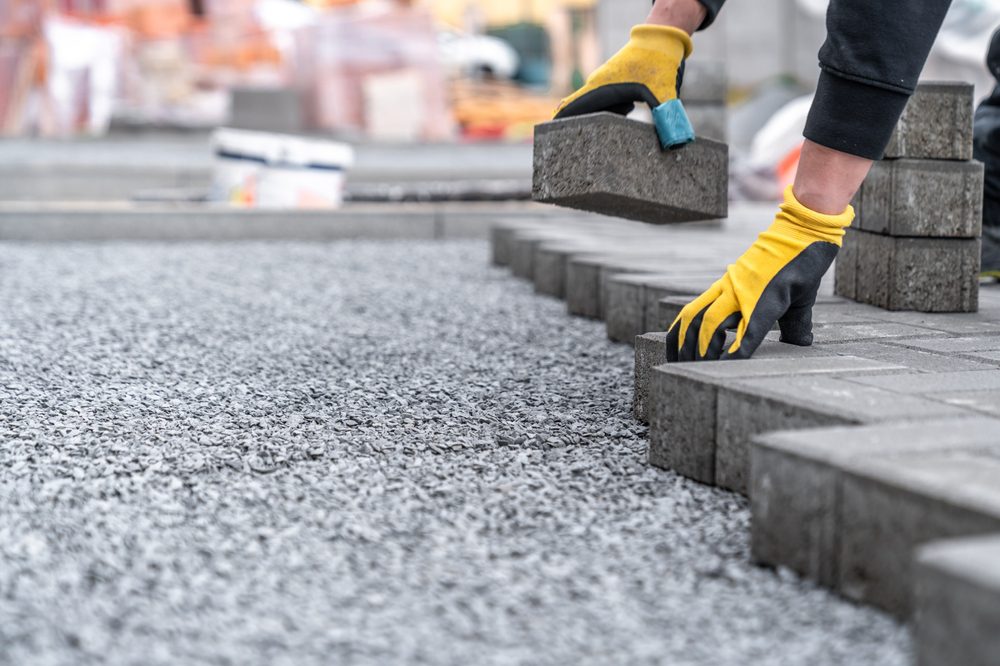You have probably seen those pretty patios, walkways, and driveways made of pavers and wondered what exactly pavers are. The following comprehensive guide explores what pavers are, their various forms, pros and cons, and exactly how they improve any landscape project. It’s about transforming outdoor spaces into functional and aesthetically pleasing areas.
What are pavers? They are paving stones, tiles, or bricks that are used as outdoor flooring. Think of them as individual pieces combined to create a stunning, durable surface for a paver patio, pool deck, or driveway.
What is Pavers: A Deep Dive into Materials
Pavers aren’t a one-size-fits-all product. With a wide variety of materials, pavers allow for customizing style and meeting specific project needs, including weather conditions, foot traffic volume, and budget. Here’s a breakdown of the main types of paving stones:
Concrete Pavers
Concrete pavers have the highest percentage and are very versatile. Durable and economical, they come in hundreds of different colors, shapes, and textures. Concrete pavers in Bucks County can even come in shades that look like clay brick or natural stone at a more budgetary price.
Brick Pavers
For a classic, warm appearance, brick pavers are a great option. These are fired from natural clay and are ideal for color retention. Clay brick pavers work well with most architectural styles. From classic to contemporary, these pavers complement any outdoor living space.
Natural Stone Pavers
Natural stone pavers boast unparalleled hardness and natural beauty. Limestone and granite give garden pathways and patios organic texture. Whether your choice is flagstone, limestone, sandstone, or granite, the natural stone paver will add elegance to any outdoor space for years to come.
Benefits of Using Pavers: Why They’re a Popular Choice
Now you understand what pavers are, but why are they preferred over poured concrete or asphalt? Here are some primary benefits of pavers.
Long-Lasting Durability
The pavers are durable, taking harsh weather conditions and heavy traffic well, unlike the ones made from poured concrete. They resist the stress that could cause them to crack. When damaged, the individual pavers can be replaced rather easily, unlike concrete slabs, which require more extensive repairs.
Design Flexibility
From swirling patterns to clean lines, pavers are incredibly versatile. The diversity of shapes, sizes, and colors allows for an almost endless variety of designs in popular applications, such as paver patios and walkways. Pavers offer versatility not often available in other paving materials.
Easy Upkeep
Another key benefit is the low maintenance involved. Pavers usually need no more than sweeping or periodic pressure washing. Sealing the pavers once every few years increases their look and durability.
Repairs are also easy since individual pavers can be replaced. Pavers are more durable than other materials like poured concrete, which needs more expensive repairs for stained concrete or cracked concrete slabs. It also requires more ongoing lawn care maintenance than is required with paving stones. Our brick repair specialists in Bucks County are here to help and make sure your path is in top shape.
Installation and Maintenance: Ensuring a Smooth Process
Installation of the paver surface is done with certain steps right from subsoil preparation to the finishing touches. Here is some general information on methods for correct installation of various types of common patio pavers and driveway pavers.
Installing Pavers
The proper base material is paramount for successful paver installation. This begins with compacted gravel, with an additional edging system. Base depth will depend upon the base material conditions of local soils and the intended use.
In areas where the soil conditions are not amenable, the base has to be deeper. The Interlocking Concrete Pavement Institute gives recommendations for a paver’s proper aspect ratio, taking into consideration length and thickness for different uses and applications. This ensures stability in high-traffic areas and under various weather conditions.
Polymeric sand between joints reduces the growth of weeds. Good installation, from choosing the right kind of paving stone to the base material, will prevent pavers from settling, therefore reducing problems of sinking pavers in the future. The best details whereby a good base for your installation of pavers have superior drainage. Both stability and drainage are greatly achieved by installing interlocking concrete pavements as well as other forms of interlocking pavers.
Maintaining Pavers
Maintenance keeps pavers looking their best. Regular sweeping and pressure washing to remove debris should be done, and one should catch weeds early.
One may also use an oil-, grease-, or rust-stain specialized paver cleaner. For the ones that have sunk, remove the paver, just correct the base, and relay the paver. The application of polymeric sand may help avert the problem and thus prevent pavers from having an uneven surface.
Conclusion
Pavers are diverse, durable, and graceful alternatives for your hardscaping needs. Pavers add beauty and value to any outdoor living space. From concrete pavers to natural stone pavers and all types in between, pavers add life to walkways, driveways, patios, and other landscaping projects. One major reason people choose pavers is that they can last for many, many years.
Their reliability comes from their ease of installation, ongoing upkeep, design diversity, and variety of colors and materials. Pavers require only a bit of effort to retain color and maintain integrity even in heavy foot traffic and extreme weather conditions. They add beauty and practicality to an outdoor living area. This can include popular paver uses such as paver patios and pool decks.
Ready to take your patio to the next level? Contact us today!


